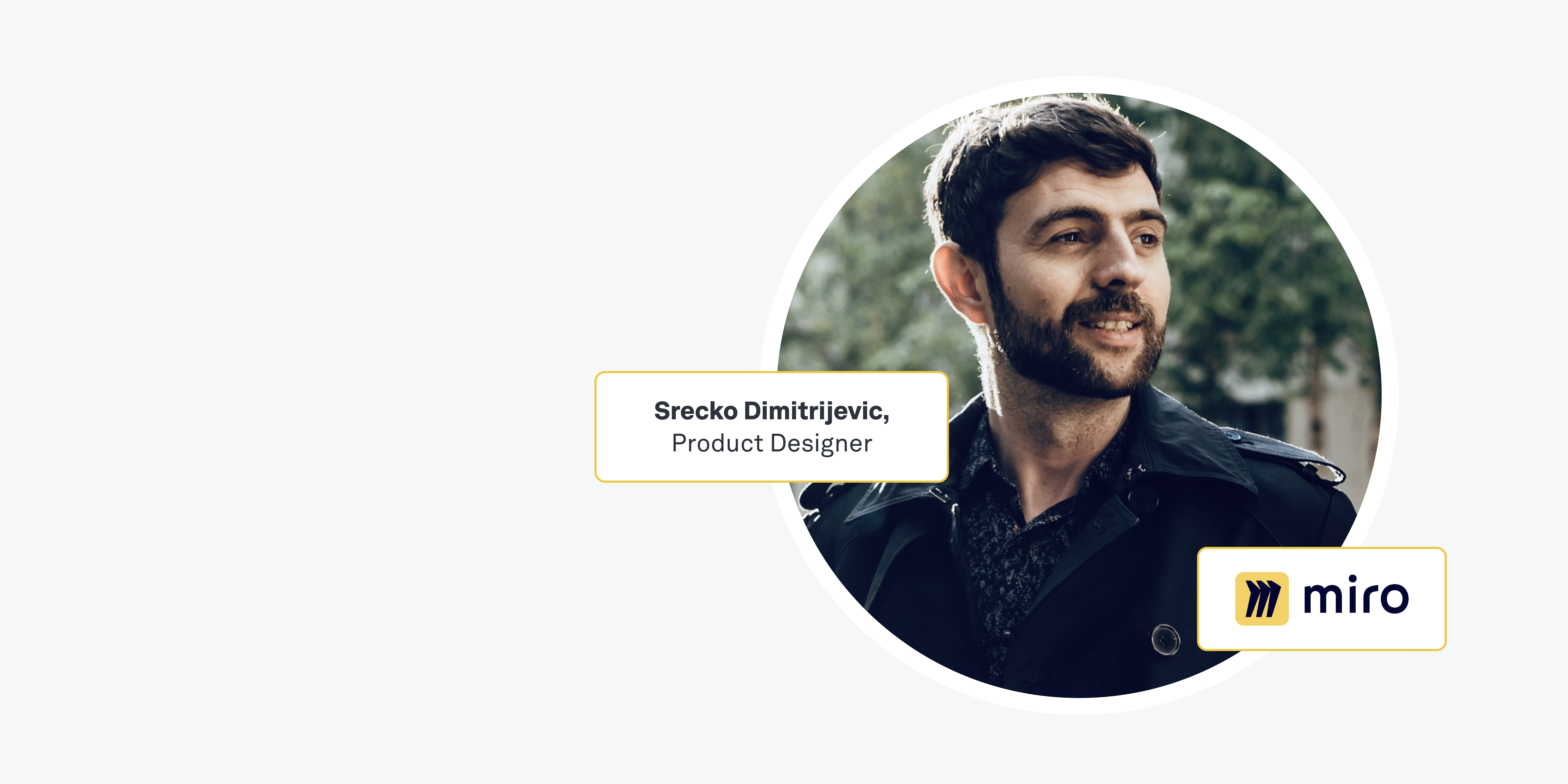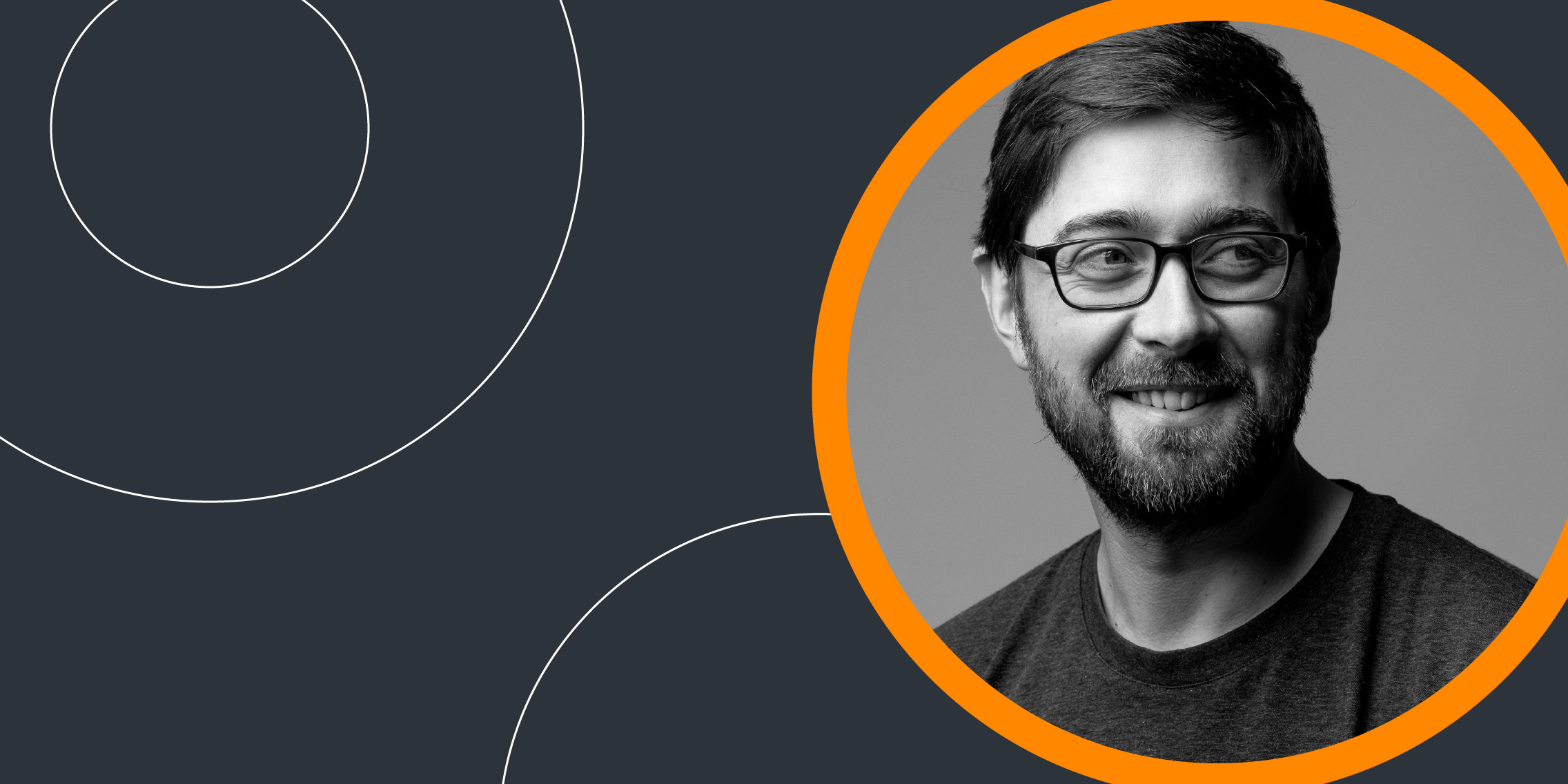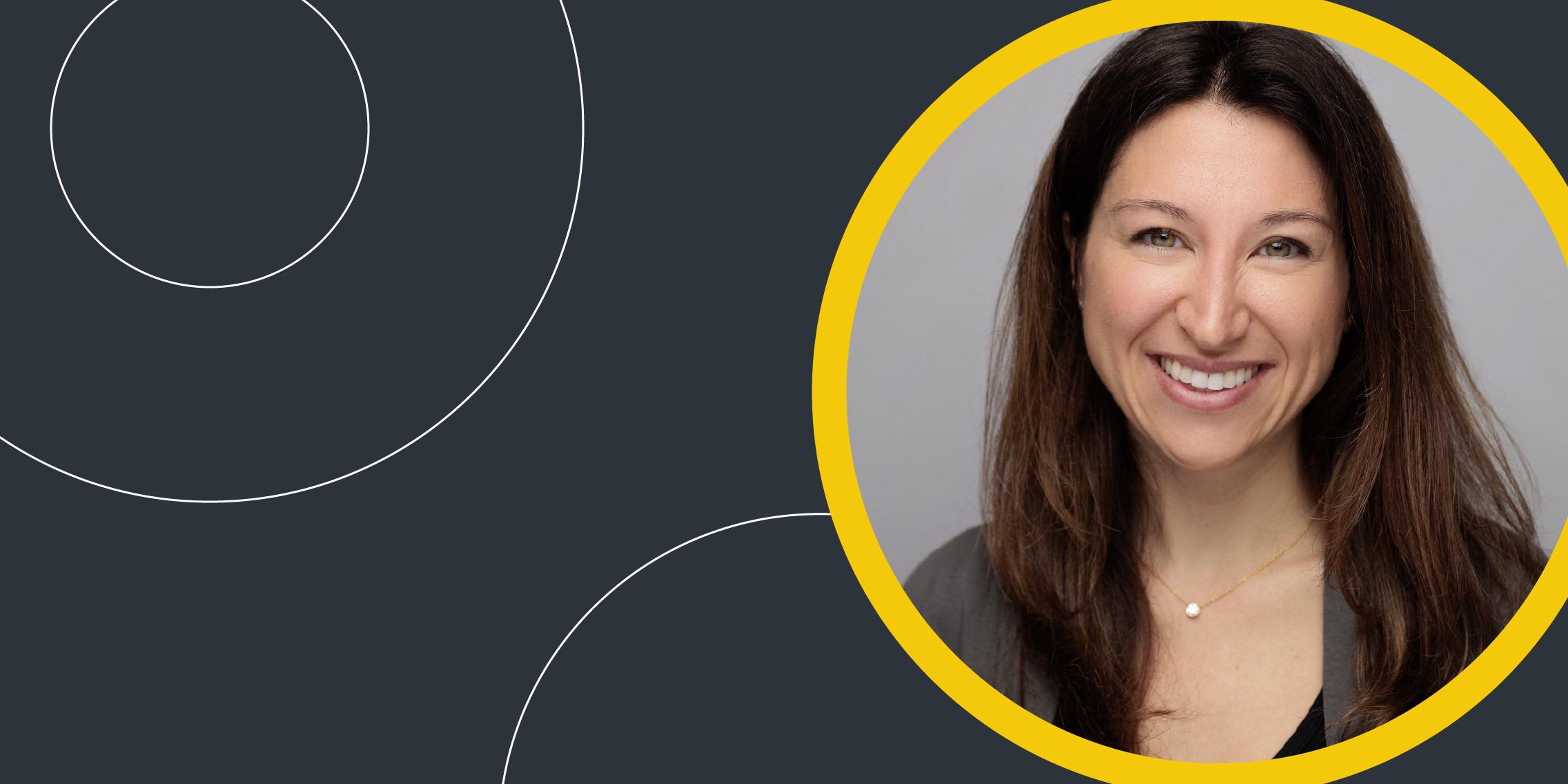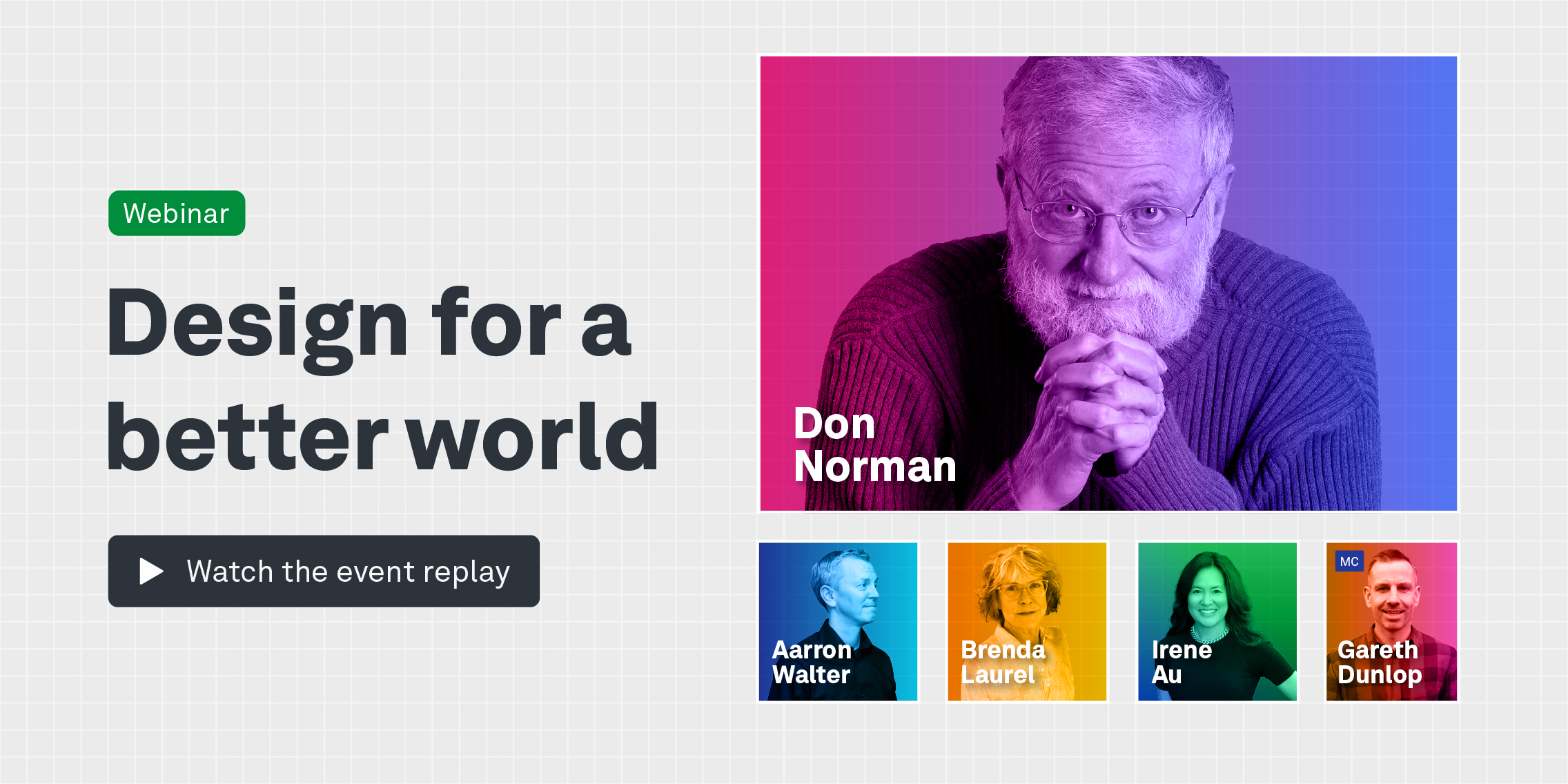We recently had the privilege of chatting to Srecko Dimitrijevic, a Product Designer with Miro, as part of our Day in the Life live event, which you can watch here.
Formed in 2011, Miro is the virtual whiteboard that allows teams to brainstorm and collaborate as they work in-office, remotely or take the hybrid approach. Over 35 million people use Miro across the globe and in one of our recent LinkedIn surveys, 44% of our poll takers voted Miro as the best documentation tool in UX.
With over 14 years behind him in design, Srecko’s design thinking helps users to adapt to the new normal ways of working and allows them to get things done at their own pace. He shares his insights on how he has adapted to new design roles and how leaving his comfort zone wasn’t necessarily a bad thing.
Could you talk us through your professional journey ?
When I graduated as a baby designer around 2008, I worked as a graphic designer all the way to art director in a marketing agency. After that, I moved towards visual design and UI design, where I was working freelance for a New York-based company with various industry clients. The next stepping stone was actually having my own studio from 2015 to 2017, where I was working mostly with US-based healthcare startups.
In 2017, I made a big change and decided to live abroad outside of Serbia to become more focused on product development and work with an actual product development, cross-functional team. This is when I moved to Germany. I had a couple of things here. The first step here was Zattoo, which was like Netflix for TV content. I moved from the entertainment industry into Ada, which is a diagnostic app for the healthcare industry, in 2020. After that, I worked with Softgarden for a year on an applicant tracking system for recruitment. And here we are today Miro. As you can see, I made a lot of switches.
Tell us a little bit about your responsibilities as a product designer with Miro.
First of all, my team and I were working on asynchronous collaboration. In simple human language, what that means is it’s two or more people working on the same project at a different time or place. Time is the most important factor. Within the team, as a product designer, my main responsibility is advocating for great UX and the great experience as much as we can achieve.
We’d love to hear a little bit about the many different roles within Miro and how you actually handle working with a cross-functional team.
When it comes to my cross-functional team, it’s not that hard because I have a really awesome, awesome team of developers, Product Manager and development lead. In general, especially in a company of this kind of size, you need to constantly align with the people and step back to understand how what you’re doing fits in with the overall strategy. So you can imagine that if I want to do something, I really need to align with a Canvas team, I need to talk to core product.
So with everything, you need to talk to people. And I think overcommunication is the way to go. It’s the best recipe. Something that has worked for me is that you need to constantly praise what you’re doing and how you want to do it. You need to have a rationale of what you’re doing and, of course, talk to a lot of people. I think the more senior you get, the more you talk.
Who would be the main people you communicate with on a daily basis?
On a daily basis, that’s mighty. There’s the holy trinity of design, product and development. My day would start preferably around 10, where I can go through our JIRA backlog, do tasks or just talk directly to my Product Manager and development lead – taking a look at what’s at hand, what we want to tackle first. These are the people that I talk to a lot – it’s like my family here.
Another layer is that Miro is huge and as a design team, we need to have a lot of meetings to align and to make sure that what you do is in compliance with your whole chapter and with the rest of the product.
How do you make design an accessible and approachable conversation topic?
There are, in my opinion, two ways. So first of all, it’s a very simple one and that can be realising that you are speaking to people in a different language. If I talk to you designer to designer, then we will probably discuss flows, interactions, how something should work. It’s all about user experience. If I talk about the very same thing but to the Product Manager, then I’m going to talk more about the timeline about how it fits into strategic needs, how we’re going to present it to the top level management. If you talk to developers, imagine the very same screen that you’re presenting. You’re not going to come to them and say “Hey, this is the colour purple”. You will talk in technical terms about how that colour can be implemented in CSS, etc.
Secondly, I actually think that the primary role of a designer is to continuously facilitate the environment for people so they can participate in design. It’s very important to enable people to participate in design decisions and to be designers as well.
How long do you spend on a design project?
I’m not sure if you can answer that very simply. But let’s say that the average time could be around six to eight months and you need to not drop the ball in a way. That’s one of the important things because you need to spread that passion all the way through and to maintain that level as much as you can to the end. Unless you’re doing some slight and simple changes in the UI, design projects aren’t very short because you need to go through the discovery phase and then you need to sort to understand the market. You need to define the problem that you have and then eventually solve it. It takes time with all the research coming in and other activities and alignments as I was mentioned before.
As a designer, you’re obviously into the details. How easy is it for you to step back and look at that bigger picture?
It’s not – that’s the short answer. That’s the king of all pitfalls, right? Even now, it happens from time to time. I use advice from a very good friend of mine. He always thinks “what can go wrong?” and that’s a very good ace to have up your sleeve to keep you on your toes. What can go wrong? How? So how can I zoom out a bit? It’s not by magic wand or whatever. It’s by talking to people and understanding. When we work with other teams, we go to them immediately to understand what they’re working on and how we can align. This is what the bigger picture is but it’s a serious pitfall because what we’re doing is very rapid, right?
People always expect velocity from us. That’s a real life situation – people expect you to do things of high quality and as fast as possible.
Could you talk us through the structure of your design team?
When it comes to the design team, we have a big group, our group and everyone goes into different cross-functional teams in their chapter. There are three teams in my chapter, which is visual structuring and we’re working on different stuff there. Each part of the product would have their own managers and, of course, you have our Head of Design. It’s great that Miro has designers sitting at a table and discussing important stuff, strategically and business wise.
With over 14 years of experience in design, do you think it’s become easier to advocate for good UX?
I want to say yes, but no, I don’t think that would be the honest answer. I need to constantly explain why we are doing this. I’m not just talking about a general direction, even with simple feature details. You always need to say stuff like, “I did this because if we do this way, I believe it’s going to meet the user’s needs in a better way”.
We really need to constantly talk and talk.
Another very tangible situation would be before any decision, I like to do a workshop and then ideate on it.
Do you have any advice for junior designers who want to approach their managers so that they can implement more UX into their work?
What has worked for me so far is to be very transparent. This one is blurry but you need to have clear responsibility in the sense that you understand where their priorities lie and split the tasks. Another thing that is important for a designer, in my opinion, is to present yourself as a service.
Your role in the team is to constantly fit with possibilities and then it’s mostly up to the product team to pick which one works the best together with you.
Let’s talk a little bit about imposter syndrome. How often do you experience it in your career?
I haven’t had that recently but encountered it in the beginning and middle of my career. I tried to face it to understand what it is and it’s being uncomfortable due to lack of knowledge. Let’s say I am new to the discovery phase. I need to understand how to look into market, I need to understand how to talk to researchers. If I don’t know that, of course, I’m going to feel like an imposter because I’m lacking this knowledge. If you’re at the beginning of your career and are starting in design, just talk to people again and be very honest. Say, “look, I’m not comfortable with this”.
Every failure is a stepping stone to success.
You will feel uncomfortable but one good point to know is that the people who hired you, they hired you. So why would you think that you’re not good?
They saw something new and you should appreciate that and just relax.
And, finally, for people who are studying or taking courses, what advice would you give to people who are very, very fresh to the product design and UX world?
You should always have rationale for your decisions. It means that you did your homework, that you really understood the problem. When you do a certain design, you should have a reason why you did it and that reason shouldn’t be a hunch or something like that. It should be evidence-based reasons. Heavy rationale will anticipate a lot of questions that you’re gonna get down the road and the more you understand, the more confident you will talk about it.




